Micromachining of High Quality PMN–31%PT Single Crystals for High-Frequency (>20 MHz) Ultrasonic Array Transducer Applications
Abstract
1. Introduction
2. Materials and Methods
3. Results and Discussion
3.1. Geometry of Kerf
3.2. Piezoelectric Characterization
4. Conclusions
Author Contributions
Funding
Conflicts of Interest
Abbreviations
| PMN–PT | Pb(Mg1/3Nb2/3)–PbTiO3 |
| PZT | Pb[Zr(x)Ti(1-x)]O3 |
| BT | BaTiO3 |
| OM | Optical microscope |
| SEM | Scanning electron microscope |
| PLM | Polarized light microscope |
| PFM | Piezoresponse force microscopy |
References
- Service, R.F. Shape-Changing Crystals Get Shiftier. Science 1997, 275, 1878. [Google Scholar] [CrossRef]
- Sherlock, N.P.; Zhang, S.; Luo, J.; Lee, H.Y.; Shrout, T.R.; Meyer, R.J. Large signal electromechanical properties of low loss (1-x)Pb(Mg1/3Nb2/3)O3-xPbTiO3 single crystals. JAP 2010, 107, 1804. [Google Scholar] [CrossRef]
- Qiu, C.; Wang, B.; Zhang, N.; Zhang, S.; Liu, J.; Walker, D.; Wang, Y.; Tian, H.; Shrout, T.R.; Xu, Z.; et al. Transparent ferroelectric crystals with ultrahigh piezoelectricity. Nature 2020, 577, 350–354. [Google Scholar] [CrossRef] [PubMed]
- Li, F.; Lin, D.; Chen, Z.; Cheng, Z.; Wang, J.; Li, C.; Xu, Z.; Huang, Q.; Liao, X.; Chen, L.-Q.; et al. Ultrahigh piezoelectricity in ferroelectric ceramics by design. Nat. Mater. 2018, 17, 349–354. [Google Scholar] [CrossRef] [PubMed]
- Zhang, S.; Li, F. High Performance Ferroelectric Relaxor-PbTiO3 Single Crystals: Status and Perspective. JAP 2012, 111, 031341. [Google Scholar] [CrossRef]
- Chen, Y.; Lam, K.H.; Zhou, D.; Qingwen, Y.; Yu, Y.; Wu, J.; Qiu, W.; Sun, L.; Zhang, C.; Luo, H.; et al. High Performance Relaxor-Based Ferroelectric Single Crystals for Ultrasonic Transducer Applications. Sensors 2014, 14, 13730–13758. [Google Scholar] [CrossRef]
- Sun, P.; Wang, G.; Wu, D.; Zhu, B.; Hu, C.; Liu, C.; Djuth, F.; Zhou, Q.; Shung, K. High Frequency PMN-PT 1-3 Composite Transducer for Ultrasonic Imaging Application. Ferroelectrics 2010, 408, 120–128. [Google Scholar] [CrossRef]
- Liu, C.; Djuth, F.; Li, X.; Chen, R.; Zhou, Q.; Shung, K. Micromachined High Frequency PMN-PT/Epoxy 1-3 Composite Ultrasonic Annular Array. Ultrasonics 2011, 52, 497–502. [Google Scholar] [CrossRef]
- Yamamoto, N.; Yamashita, Y.; Hosono, Y.; Itsumi, K. Electrical and physical properties of repoled PMN–PT single-crystal sliver transducer. Sens. Actuators A Phys. 2013, 200, 16–20. [Google Scholar] [CrossRef]
- Kasuya, Y.; Sato, Y.; Urakami, R.; Yamada, K.; Teranishi, R.; Kaneko, K. Electron microscopic analysis of surface damaged layer in Pb(Mg1/3Nb2/3)O3–PbTiO3 single crystal. JaJAP 2017, 56, 010312. [Google Scholar] [CrossRef]
- Liu, C.; Djuth, F.; Zhou, Q.; Shung, K. Micromachining Techniques in Developing High-Frequency Piezoelectric Composite Ultrasonic Array Transducers. IEEE Trans. Ultrason. Ferroelectr. Freq. Control 2013, 60, 2615–2625. [Google Scholar] [CrossRef] [PubMed][Green Version]
- Smiljanić, M.M.; Lazić, Ž.; Jović, V.; Radjenović, B.; Radmilović-Radjenović, M. Etching of Uncompensated Convex Corners with Sides along <n10> and <100> in 25 wt% TMAH at 80 °C. Micromachines 2020, 11, 253. [Google Scholar] [CrossRef] [PubMed]
- Han, C.; Li, C.; Zhao, Y.; Li, B.; Wei, X. Research on a Micro-Processing Technology for Fabricating Complex Structures in Single-Crystal Quartz. Micromachines 2020, 11, 337. [Google Scholar] [CrossRef]
- Akan, R.; Frisk, T.; Lundberg, F.; Ohlin, H.; Johansson, U.; Li, K.; Sakdinawat, A.; Vogt, U. Metal-Assisted Chemical Etching and Electroless Deposition for Fabrication of Hard X-ray Pd/Si Zone Plates. Micromachines 2020, 11, 301. [Google Scholar] [CrossRef] [PubMed]
- Gaudiuso, C.V.; Volpe, A.; Ancona, A. One-Step Femtosecond Laser Stealth Dicing of Quartz. Micromachines 2020, 11, 327. [Google Scholar] [CrossRef] [PubMed]
- Le, H.; Penchev, P.; Henrottin, A.; Bruneel, D.; Nasrollahi, V.; Ramos-de-Campos, J.A.; Dimov, S. Effects of Top-hat Laser Beam Processing and Scanning Strategies in Laser Micro-Structuring. Micromachines 2020, 11, 221. [Google Scholar] [CrossRef]
- Tian, J.; Yao, H.; Cavillon, M.; Garcia-Caurel, E.; Ossikovski, R.; Stchakovsky, M.; Eypert, C.; Poumellec, B.; Lancry, M.A. Comparison between Nanogratings-Based and Stress-Engineered Waveplates Written by Femtosecond Laser in Silica. Micromachines 2020, 11, 131. [Google Scholar] [CrossRef]
- Ashforth, S.A.; Oosterbeek, R.N.; Bodley, O.L.C.; Mohr, C.; Aguergaray, C.; Simpson, M.C. Femtosecond lasers for high-precision orthopedic surgery. Lasers Med. Sci. 2019. [Google Scholar] [CrossRef]
- Snook, K.; Hu, C.-H.; Shrout, T.; Shung, K. High-frequency ultrasound annular-array imaging. Part I: Array design and fabrication. IEEE Trans. Ultrason. Ferroelectr. Freq. Control 2006, 53, 300–308. [Google Scholar] [CrossRef]
- Lukacs, M.; Yin, J.; Pang, G.; Garcia, R.; Cherin, E.; Williams, R.; Mehi, J. Performance and Characterization of New Micromachined High-Frequency Linear Arrays. IEEE Trans. Ultrason. Ferroelectr. Freq. Control 2006, 53, 1719–1729. [Google Scholar] [CrossRef]
- Foster, F.S.; Mehi, J.; Lukacs, M.; Hirson, D.; White, C.; Chaggares, C.; Needles, A. A New 15–50 MHz Array-Based Micro-Ultrasound Scanner for Preclinical Imaging. Ultrasound Med. Biol. 2009, 35, 1700–1708. [Google Scholar] [CrossRef] [PubMed]
- Brown, J.; Demore, C.; Lockwood, G. Design and fabrication of annular arrays for high-frequency ultrasound. IEEE Trans. Ultrason. Ferroelectr. Freq. Control 2004, 51, 1010–1017. [Google Scholar] [CrossRef] [PubMed]
- Chen, J.; Lam, K.H.; Dai, J.; Zhang, C.; Zhang, Z.; Feng, G. 35 MHz PMN-PT single crystal annular array ultrasonic transducer. InFer 2012, 139. [Google Scholar] [CrossRef]
- Wong, C.-M.; Chen, Y.; Luo, H.; Dai, J.; Lam, K.H.; Chan, H. Development of a 20-MHz Wide-Bandwidth PMN-PT Single Crystal Phased-Array Ultrasound Transducer. Ultrasonics 2016, 73. [Google Scholar] [CrossRef]
- Yao, J.; Yang, Y.; Ge, W.; Li, J.; Viehland, D. Domain Evolution in PbMg1/3Nb2/3O3–60at%PbTiO3 with Temperature and Electric Field. J. Am. Ceram. Soc. 2011, 94, 2479–2482. [Google Scholar] [CrossRef]
- Rao, W.; Wang, Y. Domain Wall Broadening Mechanism for Domain Size Effect of Enhanced Piezoelectricity in Crystallographically Engineered Ferroelectric Single Crystals. ApPhL 2007, 90, 041915. [Google Scholar] [CrossRef]
- Ahluwalia, R.; Lookman, T.; Saxena, A.; Cao, W. Domain Size Dependence of Piezoelectric Properties of Ferroelectrics. PhRvB 2004, 72. [Google Scholar] [CrossRef]
- Lin, D.; Zhang, S.; Li, Z.; Li, F.; Xu, Z.; Wada, S.; Luo, J.; Shrout, T. Domain size engineering in tetragonal Pb(In1/2Nb1/2)O3-Pb(Mg1/3Nb2/3)O3-PbTiO3 crystals. JAP 2011, 110, 084110. [Google Scholar] [CrossRef]
- Gattass, R.; Mazur, E. Femtosecond Laser Micromachining in Transparent Materials. Nat. Photonics 2008, 2, 219–225. [Google Scholar] [CrossRef]
- Wang, D.J.N.P. Femtosecond Laser Micromachining. Nat. Photonics 2003, 2, 219–225. [Google Scholar]
- Tran, D.V.; Lam, Y.C.; Zheng, H.Y.; Murukeshan, V.M.; Chai, J.C.; Hardt, D.E. Femtosecond laser processing of crystalline silicon. Opt. Lasers Eng. 2005, 43, 977. [Google Scholar] [CrossRef]
- Pecholt, B.; Gupta, S.; Molian, P. Review of laser microscale processing of silicon carbide. J. Laser Appl. 2011, 23, 012008. [Google Scholar] [CrossRef]
- Jiang, Z. PMN-PT crystal of less defects and more uniformity. In Proceedings of the International Symposium on Joint IEEE International Symposium on the Applications of Ferroelectric (ISAF), International Symposium on Integrated Functionalities (ISIF), and Piezoelectric Force Microscopy Workshop (PFM), Singapore, 24–27 May 2015; pp. 56–59. [Google Scholar]
- McKeighen, R. Design guidelines for medical ultrasonic arrays. Proc. SPIE—Int. Soc. Opt. Eng. 1998, 3341. [Google Scholar] [CrossRef]
- Zhao, K.Y.; Zhao, W.; Zeng, H.R.; Yu, H.Z.; Ruan, W.; Xu, K.Q.; Li, G.R. Tip-bias-induced domain evolution in PMN–PT transparent ceramics via piezoresponse force microscopy. ApSS 2015, 337, 125–129. [Google Scholar] [CrossRef]
- Lam, K.H.; Au, K.; Chen, J.; Dai, J.; Luo, H. Kerf profile and piezoresponse study of the laser micro-machined PMN-PT single crystal using 355 nm Nd:YAG. MaRBu 2013, 48, 3420–3423. [Google Scholar] [CrossRef]
- Liu, Y.; Lam, K.H.; Shung, K.; Li, J.; Zhou, Q. Enhanced piezoelectric performance of composite sol-gel thick films evaluated using piezoresponse force microscopy. JAP 2013, 113, 187205. [Google Scholar] [CrossRef]
- Yimnirun, R.; Unruan, M.; Laosiritaworn, Y.; Ananta, S. Change of dielectric properties of ceramics in lead magnesium niobate-lead titanate system with compressive stress. J. Phys. D Appl. Phys. 2006, 39, 3097. [Google Scholar] [CrossRef]
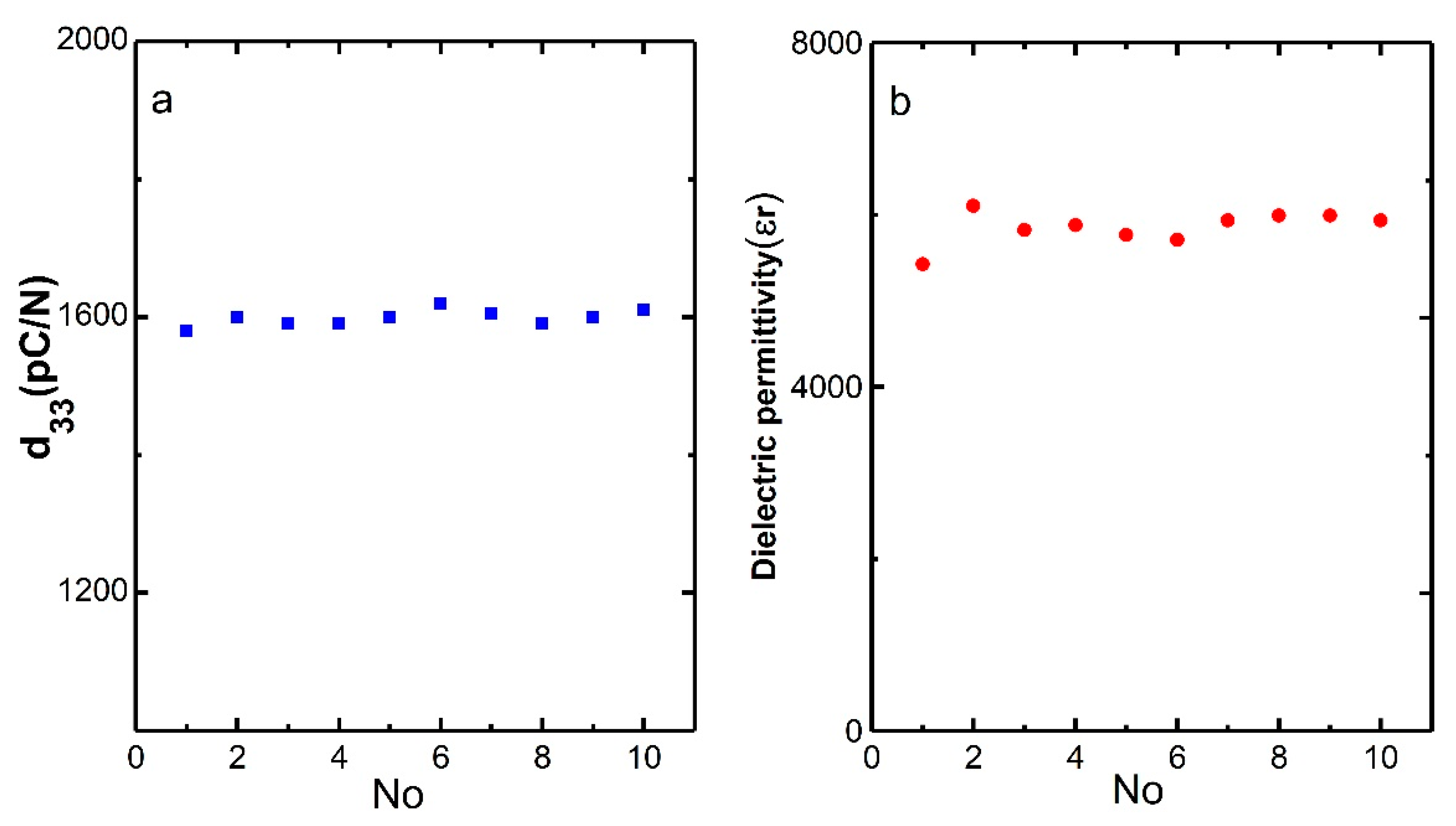
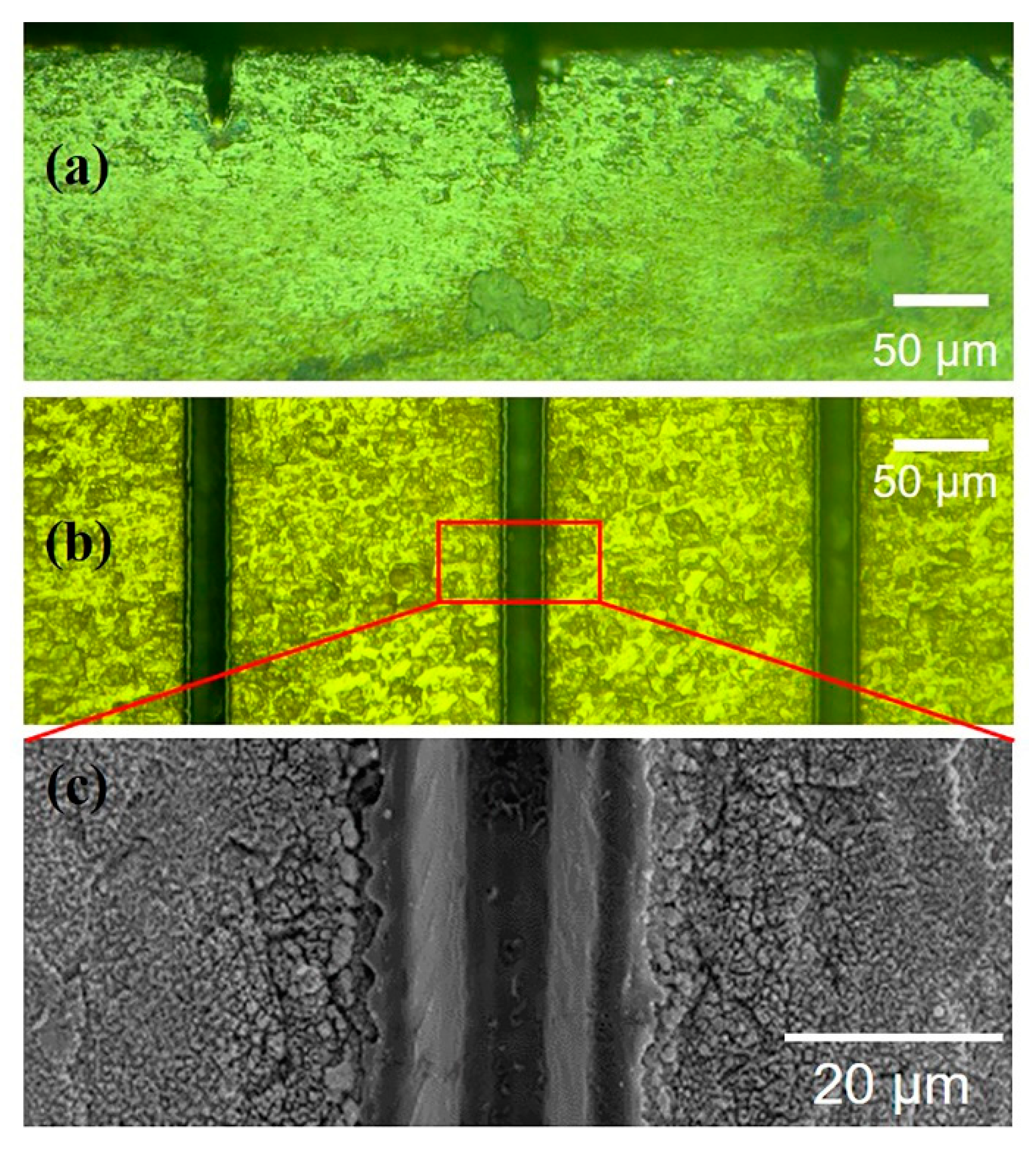
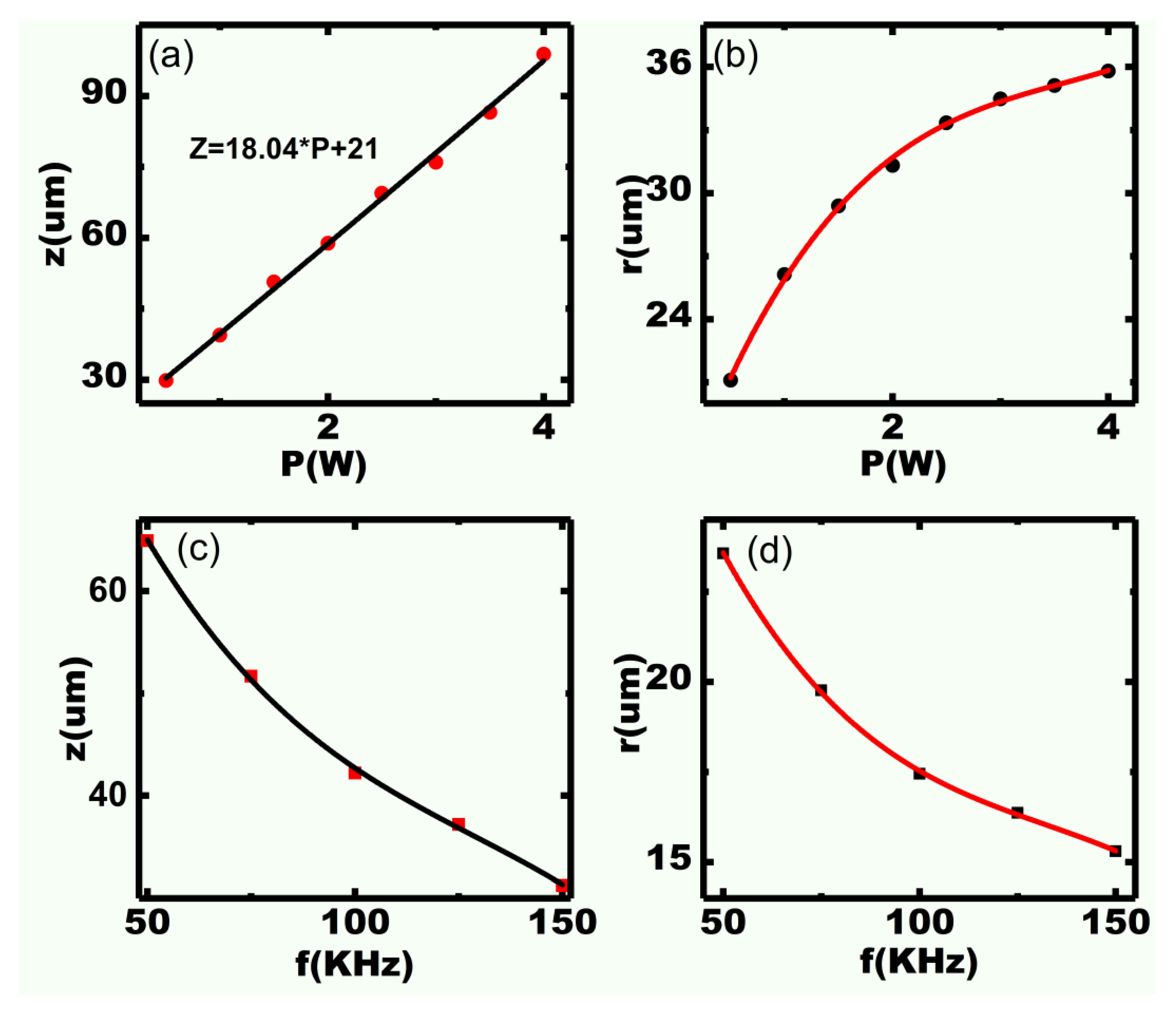
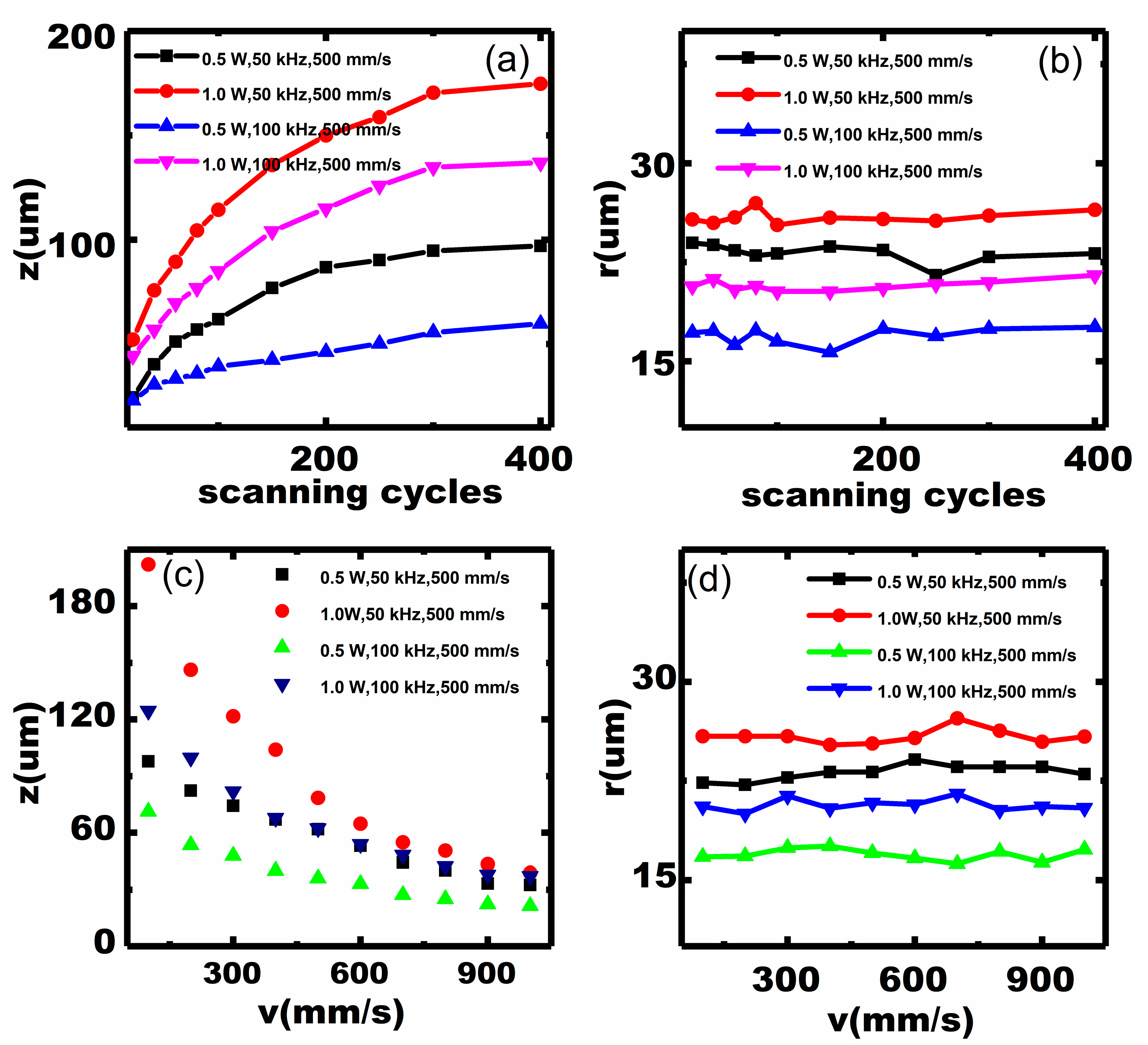


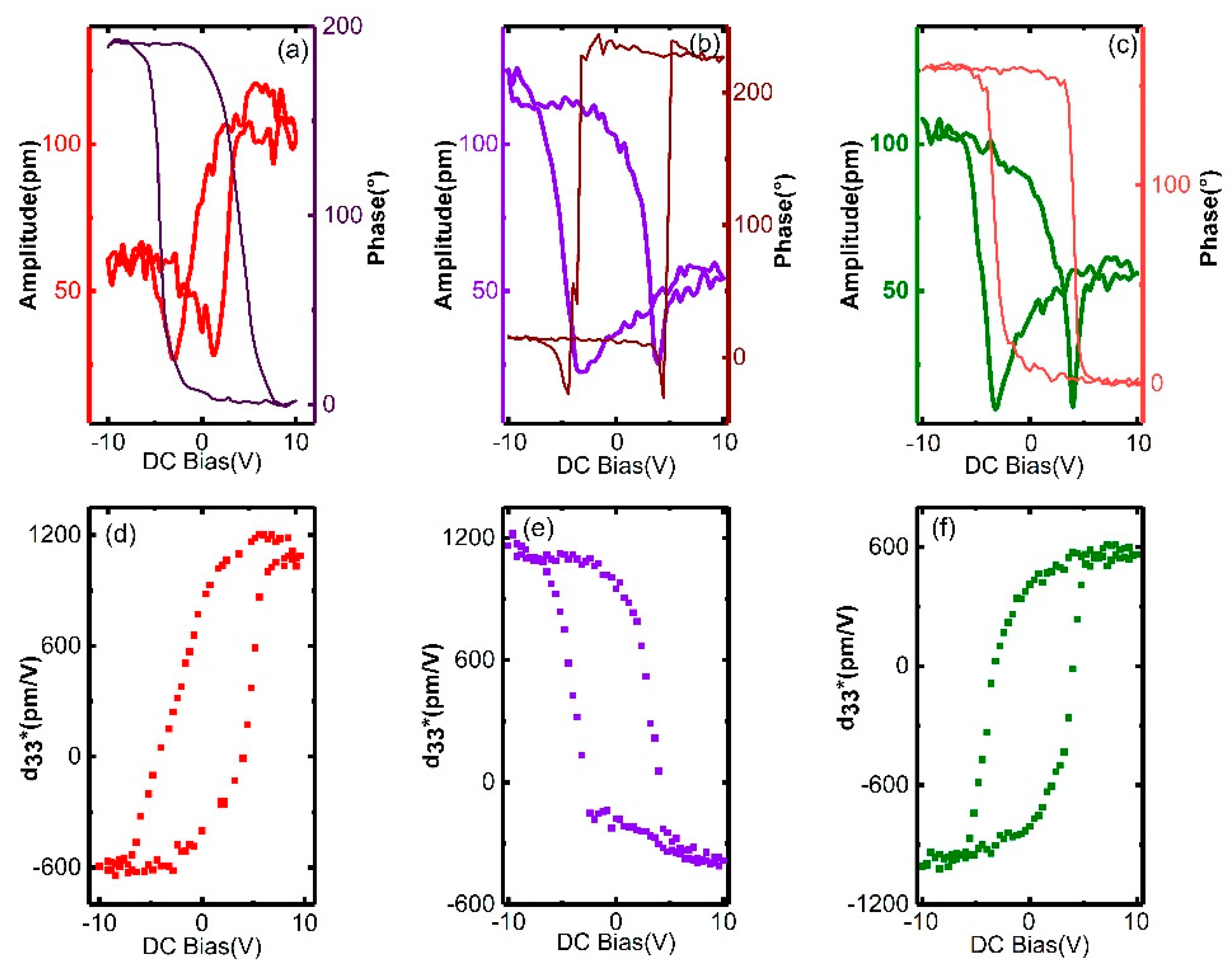
| Parameters | Specifications |
|---|---|
| Laser type | Nd:YVO4 |
| Laser power | 5 W |
| Laser wavelength | 355 nm |
| Laser pulse frequency | 25–200 kHz |
| Focused beam diameter | 20 ± 2 μm |
© 2020 by the authors. Licensee MDPI, Basel, Switzerland. This article is an open access article distributed under the terms and conditions of the Creative Commons Attribution (CC BY) license (http://creativecommons.org/licenses/by/4.0/).
Share and Cite
Lei, Z.; Chen, Y.; Xu, G.; Liu, J.; Yuan, M.; Zeng, L.; Ji, X.; Wu, D. Micromachining of High Quality PMN–31%PT Single Crystals for High-Frequency (>20 MHz) Ultrasonic Array Transducer Applications. Micromachines 2020, 11, 512. https://doi.org/10.3390/mi11050512
Lei Z, Chen Y, Xu G, Liu J, Yuan M, Zeng L, Ji X, Wu D. Micromachining of High Quality PMN–31%PT Single Crystals for High-Frequency (>20 MHz) Ultrasonic Array Transducer Applications. Micromachines. 2020; 11(5):512. https://doi.org/10.3390/mi11050512
Chicago/Turabian StyleLei, Zhihong, Yan Chen, Guisheng Xu, Jinfeng Liu, Maodan Yuan, Lvming Zeng, Xuanrong Ji, and Dawei Wu. 2020. "Micromachining of High Quality PMN–31%PT Single Crystals for High-Frequency (>20 MHz) Ultrasonic Array Transducer Applications" Micromachines 11, no. 5: 512. https://doi.org/10.3390/mi11050512
APA StyleLei, Z., Chen, Y., Xu, G., Liu, J., Yuan, M., Zeng, L., Ji, X., & Wu, D. (2020). Micromachining of High Quality PMN–31%PT Single Crystals for High-Frequency (>20 MHz) Ultrasonic Array Transducer Applications. Micromachines, 11(5), 512. https://doi.org/10.3390/mi11050512








